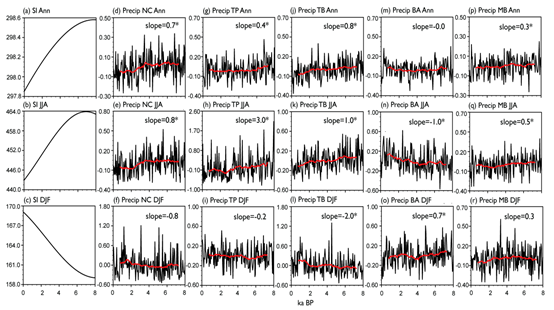Holocene Precipitation Evolution Dynamics in Central Asia Revealed
The subtropical westerly jet (SWJ) in the upper troposphere, an important atmospheric circulation system, is critical for influencing of global climate by changes of its north-south migration and intensity.
The response of precipitation over arid Central Asia since the mid Holocene is long considered to be controlled by astronomical insolation-induced changes in the westerlies. However, it is still controversial in proxy and modeling studies whether the trend of Central Asian precipitation is in accordance withAsian monsoon or not.
Recently, a joint research led by Prof. Shi Zhengguo from Institute of Earth Environment, Chinese Academy of Sciences and his collaborators conducted a high-resolution transient experiment by a coupled climate model to evaluate the response of SWJ and Central Asian precipitation.
the summer SWJ gradually migrated southward and strongly strengthened over the Central Asia, Japan and North America from the early to late Holocene; meanwhile, the position of the winter SWJ almost barely moved and slightly changed.
The variations of position and intensity of SWJ should be primarily attributed to the astronomical insolation changes. The simulated precipitation changes are distinctly different over regions although they are mainly associated with the westerlies.
Since the mid-Holocene, the annual precipitation increases over Balkhash-Altai region but decreases over Turan Plain, Mongolia-Baikal and Tarim Basin, in all of which the summer precipitation contributes most.
Following the summer insolation, the southward shift of westerly jet is accompanied by wave-like anomalies in the upper-tropospheric meridional winds across mid-latitude Eurasia (the Silk Road pattern), which results in distinct summer precipitation changes.
The decreased precipitation over Tarim is mainly explained by weakened low-level easterly wind anomaly and less moisture supply from East Asia. In contrast, the responses of winter precipitation are limited even in the winter-rainfall-dominated regime due to the small insolation change. Such simulated complicated precipitation trends during the Holocene are in qualitative agreement with existing proxies, highlighting the modulation of Silk Road pattern on Central Asian rainfall on the orbital timescale.
This work, published in Quaternary Science Reviews and Frontiers in Earth Science., is jointly supported by the Strategic Priority Research Program of Chinese Academy of Sciences and National Natural Science Foundation of China.

Fig. 1 Variations of orbital insolation over Northern Hemisphere and of precipitation rates over monsoon and arid regions for annual (top), summer (middle) and winter (bottom) during the past 8ka: (a-c) solar insolation; (d-f) precipitation averaged for North China (NC); (g-i) TP precipitation; (j-l) TB precipitation; (m-o) BA precipitation; (p-r) MB precipitation. (Image by SHI, et)

Fig. 2 Linear regressions of summer precipitation rates over four ACA regions to 700 hPa wind vectors and geopotential heights during the past 8ka: (a) TP; (b) TB; (c) BA; (d) MB. (Image by SHI, et)
Contact: Bai Jie, Institute of Earth Environment, Chinese Academy of Sciences, Xi'an, China. Email: baijie@ieecas.cn
 © 2015 Institute of Earth Environment,CAS
© 2015 Institute of Earth Environment,CAS Address:No. 97 Yanxiang Road, Xi'an 710061, Shaanxi, China

 Location :
Location :